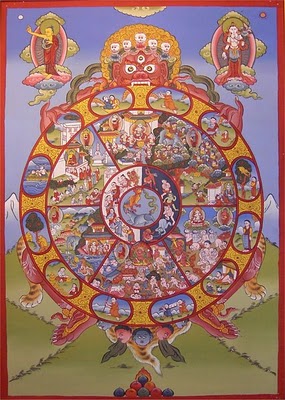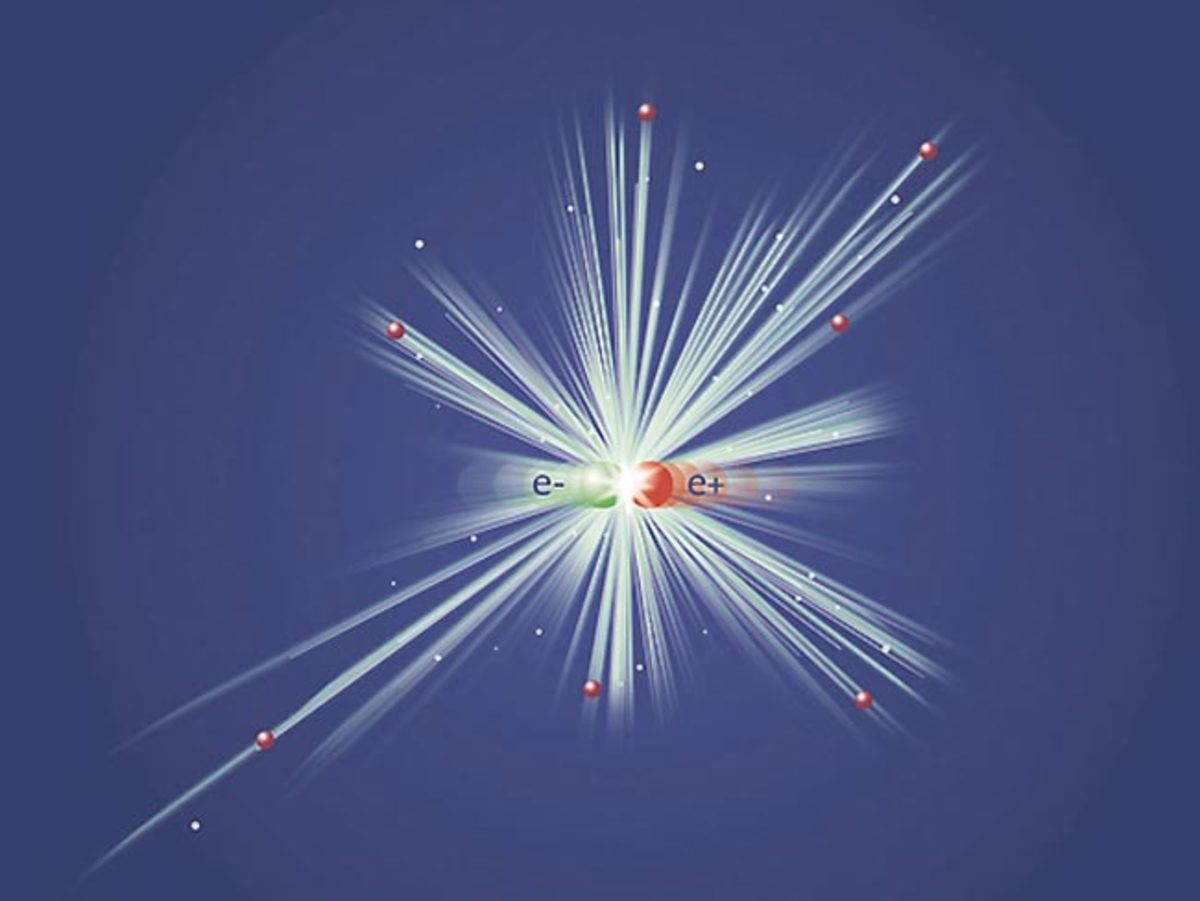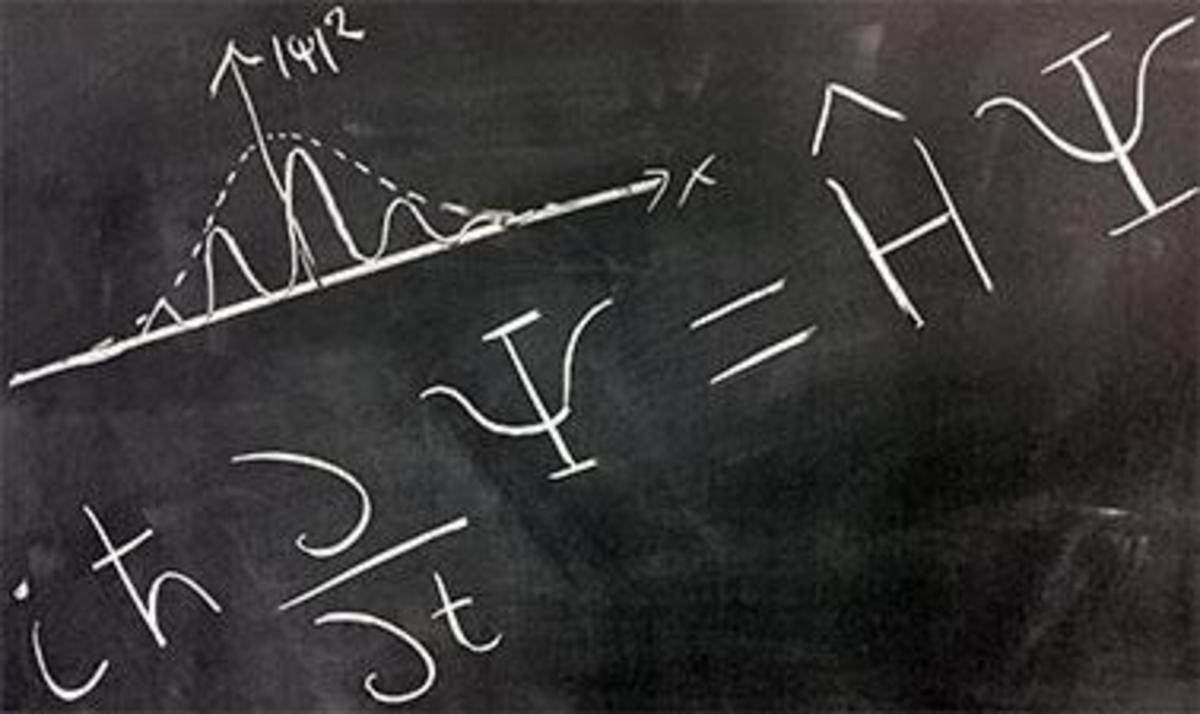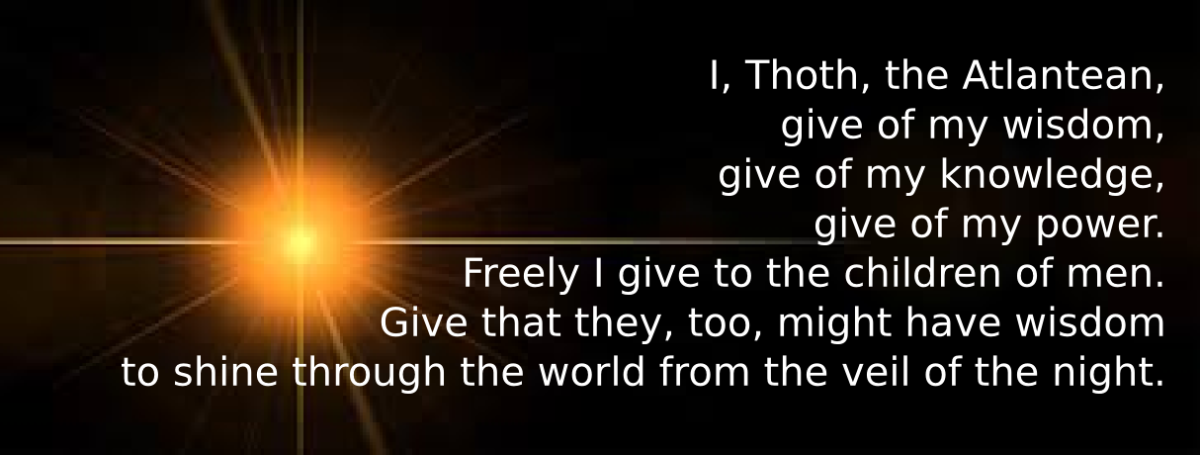Theories of how life began
There are many ideas concerning life's origina and the jury is still out!

Life is Still a Mystery
Many ideas exist on the origins of life, being creation/imagination, desire, evolution and panspermia. Life is perhaps the greatest mystery of the cosmos and ideas abound as to how it arose. Before we can address the question of life, we need to answer the question of the cosmos, which serves as the foundation for life as we know it. To begin, the question of material existence has in its foundation, the universe and its beginning. There are many hypothesis and theories of the beginnings of it all, but many agree that in the very beginning, equal amounts of matter and antimatter were created. In today's cosmos, we can divide matter further into categories of organic living matter and inorganic dead matter. According to the analysis, there should be nothing but energy, well dispersed by now. But this is far from the case as the cosmos is brimming with matter, energy and now what some say, dark matter and dark energy for which there is now some tentative proof. For now we will overlook the reality of the mass energy equivalence according to relativity as this will only complicate the picture.
The fact that matter and antimatter are created in ultra high energy environments is born out by experiments in relativistic particle collisions, observation of the poles of black holes and now from observation of a newly discovered type of super nova explosion first observed in a distant galaxy in 2006. If matter and antimatter are created equally in the beginning, why is there a preponderance of matter in the cosmos? Somehow, the two became separated. How this occurred becomes a matter of speculation. We know from direct experimentation in high energy particle physics that the two behave differently in a magnetic field, forming "mirror" image patterns of one another as they spiral in the magnetic field. It is this fact that brought antimatter to light in the first place in the experimental field.
In the very beginning, intense magnetic fields must have separated matter and antimatter into two distinct regions, preventing mutual annihilation. Magnetic fields in the beginning of the cosmos were far more intense, even greater than those found in magnetars today that have magnetic influence over vast regions of space. In addition, intense gamma radiation not only created antimatter from matter and vice versa, it also served to disperse the two violently. In our cosmos, we see preponderance for one type of matter, but have found vast patches of antimatter near galactic centers including our galaxy. Thus the existence of another separate cosmos or regions in our cosmos where the other type of matter is in greater abundance is implied. The existence of other universes is now commonly accepted among cosmologists, though as yet unproven. It could well be that this is because we can only see a limited part of the whole cosmos due to the speed of light restriction. Remembering Einstein, there is no speed of light restriction on the expansion of space, so the cosmos can be much larger than we can directly observe. Many cosmologists now accept this as given based on observation to the edge of the know cosmos at the region of ultimate red shift.
The important consideration here is that the beginning of the cosmos originated with far more mass than contained in a single 150 to 200 solar mass star. It stands to reason that such an object would be hot beyond measure with copious gamma radiation producing an equal mix of matter and antimatter well into the initial inflationary period. This created the enormous energy to drive a primordial magnetic field and to explode the cosmos outward from a tiny source. The conditions of the early cosmos altered the Planck False Vacuum State, making it unstable and creating different laws of physics in the early phase of the emergence of the cosmos. This is confirmed by observing curious changes in Fraunhoffer emission spectra from the edge of the cosmos. Matter and antimatter that did not annihilate and provide the initial thrust, were separated and driven in two separate ways, the likes of which would be difficult to describe due to different laws of physics that would have existed then. Whatever went on involved the Planck False Vacuum State directly and intimately, causing some form of feedback chain reaction. Non space and non time changed into an expanding/accelerating cosmos of space and time interacting with the Planck False Vacuum State. After the initial expansion, it settled and stabilized, evolving to what we know in this era, at least for the matter component and by implication, the antimatter part. All of this was apparently the result of unconscious natural forces extracting from the primordial conditions of the early cosmos. How life and consciousness evolved out of this developing cosmos is something else altogether.
We need to consider how such a thing evolved outside of the realm of and the constraints of mere faith and pat answers and strive for some form of objective verifiable answer. To start we need to recognize that the cosmos is a place of change and evolution from the simple to the complex due to the action of an energy gradient originating in the initial fireball of cosmic birth. The cosmos today is a complex place of matter-energy interaction where particles and energy can behave like each other and have an entangled quantum link. For the most part, this is not seen unless one knows how to look. The classic double/single slit experiment is one of those ways to peer into the secrets of the cosmos between the macro and quantum levels. It is one of those places where matter and energy can behave in similar ways and tells us about the nature of matter/mass/energy. It tells us about the cosmos and us, being part of the whole cosmos. For decades, physicists had to consider the idea that there was some conscious foundation for the results of the double/single slit experimental that was directing the results no matter how the experiment was set up. With quantum entanglement, we now have to reconsider that proposal and see consciousness as an expression of quantum entanglement in at least part of its aspects. To have consciousness, it seems that there must be a division between subject and object, observed and observer, just as there is a division between matter and antimatter or the two slits in the double slit experiment.
For a period of almost two decades, science has entered and experimented in the realm of consciousness, an area once thought to be outside of the domain of science and relegated to mystics and the faith of religious expression and acceptance. In that time period, important findings have been made regarding the nature of consciousness-unconsciousness that brings into the realm of physics and science, that which was thought to be psychological or mystical. The work of Francis Crick and others have contributed to this research.
The cosmos exists in a condition of two co-existing fundamental states, the real manifest cosmos of energy and matter and the state of the Planck False Vacuum State where virtual energy and particles “exist”. One state is in a condition of unity and the other in a state of diversity-division. Out of the Planck False Vacuum state is born such things as virtual particles which can interact with the matter of the cosmos. Further, forces such as the proven Casimir effect operate seemingly out of this "void." Virtual particles have been observed in high energy experiments and it is the interactions with the magnetic field that separate the virtual pair into matter and anti-matter parts. As long as they don't come together, they can exist in the real cosmos indefinitely.
From the early days of atomic science, we have grown to learn that matter is mostly "empty" space. The term empty space here is used conditionally considering what has already been disclosed concerning the Planck False Vacuum State and its interaction with the existing cosmos. Three dimensional space as we know it is really a fractal dimension. In other words, it is a fraction of a dimension. Further investigations into the subatomic realm demonstrate that there are subatomic particles and that these all have relationships to vibrating frequencies. It is this that gives us ideas about "string theory". Inter-penetrating vibrations suggest something more akin to a energized thought process than something made up of solid bits. Astrophysics tells us that the "solid" matter that makes up living beings can be virtually infinitely compacted. Matter and its counterpart is more akin to an idea than what we've been led to believe in otherwise.
the structures we see in three dimensions are actually closer to two dimensions, but always greater than two if just greater. When we look at galaxies, we see that they are places that are flat spirals, elliptical or spherical. They are made up of numerous stars, planets, bits and pieces and dust. They contain lots of "empty space." In fractal geometry, add to the idea, the concept of complex numbers involving real and imaginary numbers, then we enter into the realm of fractal geometry itself with its weird self similar and self affine patterns; some of which are very close to things we see in the real cosmos and in nature.
We now consider the nature of the double slit experiment that has implications for everything we understand and hold dear. The double slit experiment involving the passing of light, sound, electrons, atoms and molecules through one or two slits consistently demonstrates the curious link between matter and energy, particles and waves, individual existence and entangled states between individual ones. The one thing that is clear from this experiment is that particles and waves are two aspects of the same thing and this is what we are made of. So this reality has deep implications for us, including the idea of intuition and what is referred to as the psychic. Hard science rejects the psychic and intuition as pseudoscience, yet the very best of the theoreticians will tell us that complex equations are insolvable and the results must be intuited, such as for Einstein's Quadrapole equation and a host of other metrics. At one time, complex number equations mapping fractal patterns through iterations were outside of our ability to understand except by intuition. Now with computers, we have gone so far as to incorporate them into animated games and other applications. The entangled state allows for the intuitive no matter how expressed.
As the double slit experiment shows us that waves and particles are two aspects of the same phenomenon, we now look at the possibility that the objective cosmos and subjective consciousness are two aspects of the same thing. In other words, the cosmos and all in it are conditioned to be conscious at various intensities. Within our own human experience we are aware of differing states of consciousness. These range from complete unconsciousness to an agitated state of complete awareness. Indeed, paramedics and medical professionals have a rating scale for levels of consciousness called the Glasgow Consciousness Scale (GCS). There are fifteen distinct categories, each with their own characteristics. Fifteen represents the highest state of awareness where a person has full use of all senses, mental and physiological functions. Zero represents the state of death. The difference between the conscious and the unconscious dead is something of a matter of scale. As different beings sense things differently and live faster or slower, consciousness differs in that way. It has been established that human beings have a mental frequency of between 6 and 23 Hertz depending on whether deeply asleep or wide awake. Once more, vibrating frequency enters the picture, establishing a link between natural cosmic frequencies and frequencies of human consciousness and of life. Experiment with your own frequency and you will soon discover why movies, made out of a series of still photos shown in rapid succession, appears as a moving facsimile of reality. We run smack into the limit of our own frequency, unable to distinguish a series of rapidly displayed photographs from real life motion. There are tricks though to distinguish the two. By understanding such things we can use strobe lights to apparently bring moving machinery to a stop without actually stopping it and allowing us to analyze it while in a running state. All of these demonstrate the discrete nature of consciousness and its link with discrete quantum events. Life, which is based on quantum events is also discreet. At the foundation, the cosmos has a frequency in extreme measure, way and far greater than that of human consciousness and at an energy level that is inconceivable. At our particular frequency we miss a lot that is much faster or slower than our particular wavelength of consciousness. Is the cosmos conscious at all levels? It completely depends on how one defines consciousness. As we tend to measure things by our experience and extensions thereto by machines of various sorts, we tend to think that we are the only things that are conscious. But this may well be short sighted.
Matter as stated exists in both organic and inorganic forms. Scientists have taken inorganic matter and assembled it into an exact copy of the DNA found in a living organism. They have been able to build a replica of an entire bacterium. What they have not been able to achieve, is to bring this replica to a living condition which is demonstrated by movement, growth, feeding and reproduction. They claim that they have to do now is to learn how to "boot it up" so that the inorganic copy becomes exactly similar to the organic natural counterpart from which it was copied. They hope to achieve the same functions for something made from inorganic matter as naturally exists for the organic. Whether or not this can be done has deep implications for our understanding of life in the cosmos. So far, the experiments continue with no conclusive results as yet. Gene manipulations in living genetically modified organisms have now been found to be unstable with results that are unpredictable. GMOs share that characteristics with retroviruses. So science is experimenting with inorganic replications and with gene manipulation in a bid to better understand the nature of life.
Even within the context of our own human experience, we have different states of consciousness from deep dreamless sleep to highly agitated activity. In the deep dreamless sleep, we have no sensation of the senses or the passage of time. Yet upon waking, we resume as if nothing extraordinary occurred, so accustomed as we are to our own experiences. It is often stated by those caught up in traumatic circumstances, which the world seems to slow down into a slow motion mode. This too is a change of consciousness. We all know how fast life seems to go when we are busy or enjoying it, and how it seems to slow to tedium when bored. Thus, consciousness changes. Consciousness changes and is relative to a variety of circumstances and conditions.
Life and consciousness are inextricably bound together. Was life created by some agency separate from it, or did it evolve on its own? Is it an intrinsic part of the cosmos? For questions about life on Earth the two previous questions hold, but there is the added possibility of panspermia, i.e., that life arrived from the outside, from deep space. Yet, going back even to the beginning of the cosmos, life had to arise somehow. As the cosmos is made up of energy vibrations over virtually an infinite spectrum and that life exists in the same context, we are faced with the possibility that the cosmos and life arose together at the moment of manifestation. The Bible tells us that God created life, but only well after everything else was in place. The Vedas suggest that living entities brought the cosmos into being through imagination to allow for manifestation of all life forms. The Vedas also tell us that the cosmos goes into and out of manifestation in a cyclic fashion in a series of cosmoses called Pralayas and Manvantaras and that life carries forward from one Manvantara to the next in a kind of panspermia. Clearly life has gone through changes and is going through changes which implies evolution. It was the diversity of life that inspired the Christian Darwin to think in terms of evolution as the form of God's expression. The Buddhists tell us that life arose from desire, which is one of the ideas that is difficult to prove in any objective sense. What we do know is that we have life in the cosmos now and that it may be far more pervasive than thought just a few years ago. The ultimate answer to life is still an open question which is still under investigation. There are many theories and facts, but no unified knowledge that ties it all together in a single working whole.





